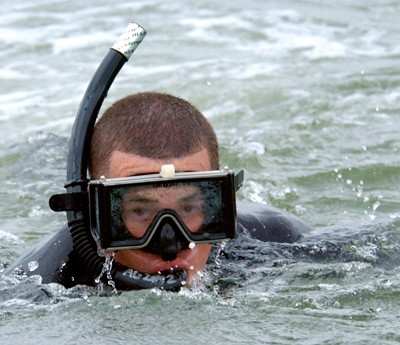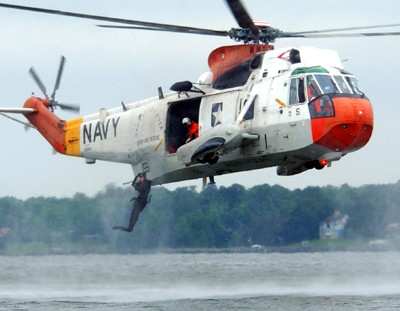Amid Change, Navy SAR Team Finishes Eval Top Of Pack
The annual search and rescue evaluation at Patuxent River Naval
Air Station (MD) is a little like a tax audit -– if, that is,
after reviewing your returns the auditors make you do pull-ups or
jump out of a helicopter into a river.

In late May evaluators from Naval Force Atlantic spent three
days examining all aspects of the NAS Patuxent River Search and
Rescue team’s operations, and left declaring the SAR team
here the best on the East Coast for the fourth year in a row.
"Like anything else, it’s a lot easier to get there than
to stay there," said Chief Hospital Corpsman Frank Bowersox
(above) of earning top honors again. "It takes constant effort
by everybody to maintain a program in the shape ours is in."
Bowersox is lead chief petty officer for the SAR team, and in
January 2005 will himself take over as SAR corpsman evaluator for
the West Coast. He leads a group that’s in flux; within the
next six months, the team will have 100 percent turnover in people,
with all the experienced program managers leaving Pax while a new
group steps up to carry on the legacy. This year’s SAR
evaluation was a chance to show the newer members how things are
done at Pax River, and what the payoffs are for the work.
Aviation Machinist’s Mate 2nd Class Mike Helvey came to
Pax last June, just after the 2003 SAR evaluation. The 25-year-old
Helvey had served in other SAR commands, and saw the differences
immediately.
"We’re a lot more by-the-book than anywhere I’ve
ever seen, and we train a whole lot harder," he said. "I
wasn’t used to training this much, but I enjoy it."
The Pax SAR mission is unique; the team exists to support the
test and evaluation flights performed by NAVAIR test pilots in
ranges over the Chesapeake Bay and Atlantic Ocean, providing
assurances to the aircrews that should anything go wrong at the
edge of the envelope, someone will be there to help get them home
safely.
Whereas many Navy commands treat SAR as something of a
collateral duty, the rescue swimmers and corpsmen that crew flights
here are dedicated almost exclusively to their life-saving mission.
That means nothing to get in the way, and no excuses for being less
than the best.
The four evaluators show up early in the morning on May 18, and
begin with a rigorous inspection of the administrative details of
the SAR program here. Like everything in the Navy, life in SAR is
built around instructions, standards, records and documentation.
The evaluators tear apart the team’s books with a harsh
scrutiny, looking for the uncrossed t’s and undotted
i’s, the little discrepancies that might reveal a shortcut
taken or a detail missed.
They come away satisfied, if robbed of the opportunity to draw
blood.
"Pax River has always set the standard as far as how these
programs are supposed to be run," said Lt. Ken Ward, who assessed
the administration of the program.
Next come the written tests, one for the rescue swimmers and
another for the corpsmen, covering abstract but critical details of
their respective professions.
"What’s the rated test strength of the Stubai Model 85
Carabineer? If a survivor is wearing an LPU-32 floatation device,
what must be done before inflating it?"
No one is stumped. The team has practiced for this portion of
the evaluation. A lot.
"We constantly beat on that stuff every day," said Aviation
Electronics Technician 2nd Class Ralphy Akery, SAR standardization
petty officer for the team.
Akery was responsible for making sure the swimmers were duly
prepared for the week long test of skills and knowledge.
"We probably handed out hundreds of practice tests," he said. "A
month before the evaluators got here, nobody was allowed to go home
until they had gotten a perfect score on the subject knowledge part
of it."
On the following day the team members are allowed to come out of
their cages a little, setting aside books and records for ropes and
dumbbells. In the morning, Akery leads evaluators to the
team’s rappelling practice site, an 80-foot tower crowned by
a now-defunct weather radar.
Standing on the steel grillwork of the platform, looking down on
the roof of the Air Operations tower across the parking lot, Akery
shows how the team rigs their ropes for the rappels. Then he and
Hospital Corpsman 2nd Class Toby Climer step out into space and
take the quick way down.
"We’re looking for standardization and safety," said Chief
Aviation Warfare Systems Operator Jim Britton, one of the swimmer
evaluators. "Especially safety."
After lunch everyone heads to the drill hall for the SAR fitness
test. First come the pull-ups, with the team circled round urging
each other on as they take their turns at the bar. The minimum is
four; a couple of the swimmers hit the 20 mark before dropping to
the ground.
Next comes the dumbbell haul, 50 pounds carried in each hand
over a 150-foot course, which includes four low obstacles that must
be cleared. Last is a timed one-mile march with a 40-pound rescue
litter strapped on the back. In the 80-something degree gym,
basketball players are walking the ball down the court in shorts
and tank-tops, while the SAR team members soak their flight suits
through with sweat, circling the perimeter of the drill hall seven
times with the orange litter bags chafing at their backs.
After the march, the rescue swimmers jump in the pool for a
500-meter solo swim, followed immediately by another 400 meters
towing a person. For most of the swimmers, touching the wall at the
end of the last lap means a well-earned break. Not so for Akery and
Aviation Electronics Technician 2nd Class Angel Gracia, who are
both chosen to demonstrate various water rescue techniques for the
evaluators.
Other team members get in the pool to play the role of ejected
aviators – some without floatation, some attached to
parachutes, some in good shape, some with broken backs. The
evaluators watch above and below the surface as the rest of the
team mills around at poolside, hoping Akery and Gracia will make
them look good. They aren’t disappointed.
On the following day it’s time to fly. Around nine in the
morning, one the SAR UH-3H Sea King helicopters lifts off from the
pad, with Lt. James Meadows at the controls and Ward in the copilot
seat. In back are Akery as rescue swimmer, Climer as corpsman and
Aviation Structural Mechanic 1st Class Adam Shiffer as crew chief.
Different evaluators will also ride along on different portions of
the flight. The crew begins a fictional rescue scenario with a
minimum of information.
"We got word that somebody saw two chutes go into the woods over
by Harpers Creek, so we went to our search and saw red smoke coming
up from the woods," Akery recalled. Another victim could be seen in
a nearby clearing.

Climer and Akery rappel 130 feet from the aircraft to the victim
in the open, and find he is "dead." They carry their gear –
medical bags, oxygen tank, litter – into the woods toward
where the signal smoke came from. A teammate plays the victim, and
an evaluator on the ground tells Climer what he finds as he
assesses injuries and administers aid. Then he and Akery put the
victim on a litter and hike him out through trees and brambles to a
suitable area for a hoist recovery.
Akery changes into a wetsuit and a new evaluator comes aboard,
then a new scenario begins: two "victims" are in the river off
Fishing Point. The helicopter passes over and the crew quickly
settles on the best strategy, based on both doctrine and
experience. Akery "direct deploys," lowering into the water on a
hoist line and staying on the line as he puts a rescue strop around
the first victim. It is a relatively new method, and Pax River was
the first command in the Navy to become certified in it.
On the next pass, Akery demonstrates a different technique,
jumping from the helo as it hovers 20 feet off the water, then
calling for a hoist recovery. Then the evaluators want to see a
rescue using the large, basket-shaped net. Before all is done,
Akery has performed six rescues, as the helicopter overhead churns
up the water with its rotorwash, creating hurricane-like
conditions.
"It would probably be like sticking your head out of a car
window in pouring rain while going 80 miles an hour," Akery said,
describing the environment. "You can’t see anything. You have
to know what to do, because there’s no way to figure it out
when you’re under the helicopter."
For this reason they sometimes train at night, without lights,
to make sure hands know the way when eyes are defeated.
Before Akery’s wetsuit has had time to dry, the evaluators
are giving their out-brief to Pax River Commanding Officer Capt.
Dane Swanson.
"All in all the Pax River SAR team is second to none in my
opinion," says Senior Chief Aviation Machinist’s Mate Steve
Barger, one of the evaluators. "They set the standard."
Swanson nods, thanks them, and tells them it’s nice to hear
what he already knew.
(ANN salutes James Darcy, NAWCAD Public Affairs
Department)
 ANN's Daily Aero-Linx (04.15.24)
ANN's Daily Aero-Linx (04.15.24) Classic Aero-TV: 'No Other Options' -- The Israeli Air Force's Danny Shapira
Classic Aero-TV: 'No Other Options' -- The Israeli Air Force's Danny Shapira Aero-News: Quote of the Day (04.15.24)
Aero-News: Quote of the Day (04.15.24) Airborne 04.16.24: RV Update, Affordable Flying Expo, Diamond Lil
Airborne 04.16.24: RV Update, Affordable Flying Expo, Diamond Lil ANN's Daily Aero-Term (04.16.24): Chart Supplement US
ANN's Daily Aero-Term (04.16.24): Chart Supplement US




